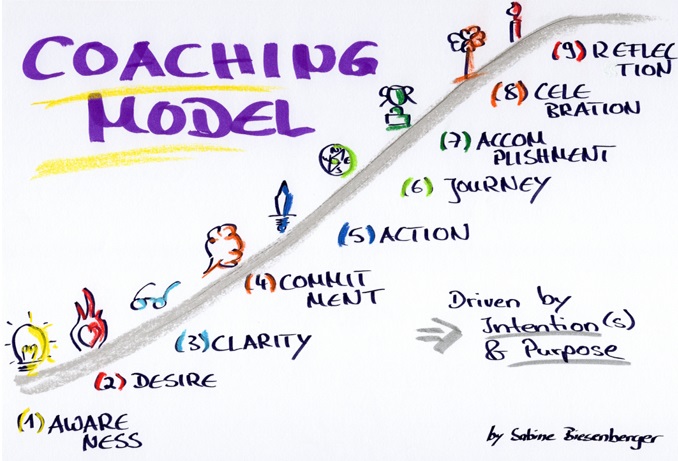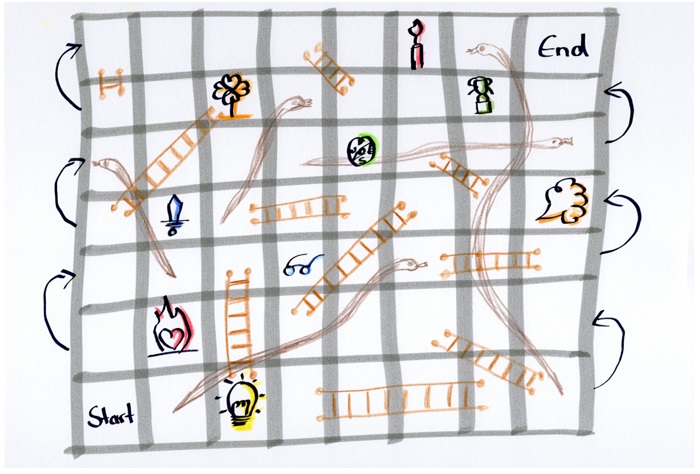A Coaching Model Created by Sabine Biesenberger
(Leadership Coaching, AUSTRALIA)
 Source: Snakes and Ladders
Source: Snakes and Ladders
Snakes and Ladders is an ancient Indian board game regarded today as a worldwide classic. It is played between two or more players on a gameboard having numbered, gridded squares. A number of “ladders” and “snakes” are pictured on the board, each connecting two specific board squares. The object of the game is to navigate one’s game piece, according to die rolls, from the start (bottom square) to the finish (top square), helped or hindered by ladders and snakes respectively.
Introduction
As a coach, one of our key objectives is to be a servant leader for our clients in their life journey, so that they can achieve what they dearly want, they can live the life they have dreamed of and/or they can become the person they have imagined. However we also know that life throws challenges at our clients, makes them doubt and sometimes push them towards something new and unexpected. What if we could introduce an analogy? One that compares life with a game – where there are supporters and opponents, rules and cheat sheets, shortcuts and lessons learned, good and bad rounds, etc.
You might say that life is way more complex and that it is the client’s accountability to create and continuously shape it, and that it is not a simple race contest based on a number on a dice, or in other words based on sheer external forces. And yes, you are right. Let me ask you a question: Think of your experiences you have had up to now and how often life was really a straight line for you rather than a ‘winded’ one? Think of your clients and ask yourself the same question.
As I like the interactions with others when playing games and the joy mixed with slight competitive tension around the table, I decided to use a game called ‘snakes and ladders’ as analogy for my coaching model: I think that life is just a little bit like the board game ‘snakes and ladders’ – no matter what your plans and efforts have been; sometimes yourself, others and/or the universe supports or challenges you in form of ‘snakes’ or ‘ladders’. By the way, the historic version of the board game had root in morality lessons, where a player’s progression up the board represented a life journey affected by virtues (ladders) and vices (snakes). Sounds familiar to our life journey? Yes? Good. You may wonder now – how does this fit with a coaching model? Well let me get started…
Coaching Model
 Figure 1: The nine key milestones of the coaching model without the ‘snakes and ladders’ context.
Figure 1: The nine key milestones of the coaching model without the ‘snakes and ladders’ context.
The foundation of my coaching model is based on nine key milestones, which can be seen as game instructions. When applying these steps first, I felt that there was something missing and that the structure was good however lacked ‘personality’. There were additional requirements to offer more flexibility, more lightness and more fun, and also to give space for any surprises in life. And I was wondering – how can this be achieved whilst utilising the existing model?
After playing a board game called ‘snakes and ladders’ with my niece and nephew recently, I had the answer: Imagine taking the process figure above and merging the milestones randomly but in sequence into the board game layout. The result is a pre-defined process/logic/sequence, however it offers also lots of flexibility, lightness and fun. For example, the speed how you move through the process, the areas that you may combine, or how many relapses or extra thrust you may experience throughout your journey is completely up to the ‘player’ and in a way the ‘universe’. There might be three steps forward at once, there might be two steps back at once, there might be just the perfect balance between speed, tension, joy and lessons learned. There are times, when you run over milestones and you don’t even realise it. And sometimes when you are at the top and you have been crowned the winner, you reflect and realise that your are ready for the next higher level or maybe that you need to go back and do a rematch. The snakes and ladders in the game are just like our own setbacks and shortcuts when going through a change. However these interventions (snakes/ladders) and which event happens when cannot be planned in advance. You can only be aware of them, prepare as good as you can and deal with them in the moment by being present and open. I see my role as a coach in facilitating the process so that neither the snakes impact the journey too much and throw the client out of the game, nor that the ladders propel the client too fast forward ignoring important milestones. A consistent and continuous check-in is vital all along the journey.
The foundation of the coaching model is even in the game context still there (even though it looks a little bit messier!), but the structure might not be clearly visible and experienced by the client as such as it happens more in the flow. Most important, it addresses the flaws experienced at the beginning whilst testing it at first. With my ‘enhanced’ coaching model, I like to provide an easy to understand or known landscape to my client that follows a structure, however that acknowledges also the ‘winded’ and ‘unique’ journey that each individual will need to go through. Compared to my initial model the enhanced one has taken into consideration the requirements of flexibility, lightness and fun during the process of following your intention and purpose in life.
 Figure 2: The nine key milestones of the coaching model in the context of ‘snakes and ladders’.
Figure 2: The nine key milestones of the coaching model in the context of ‘snakes and ladders’.
To deepen the ‘snakes and ladders’ analogy in the coaching model and to link it to its nine milestones, I created the below table for a better understanding:
| Milestones | Meaning | Snakes | Ladders |
| Awareness | Being aware of a thoughts, feelings, situation, beliefs, etc. | Own truth, judgement, reaction, disempowering beliefs, etc. | Self-awareness, feedback, reflection, etc. |
| Desire | Feeling a strong desire for the change to happen | Beliefs, lack of self love and respect, etc. | Passion, reflection, emotions, etc. |
| Clarity | Have clarity on the required area of change | Distractions, disempowering beliefs, old patterns/habits, etc. | Exploration, reflection, meditation, response, etc. |
| Commitment | Being committed to go ahead | Lack of support, lack of self respect, etc. | Can-do-attitude, empowering beliefs, strengths, etc. |
| Action | Take action as agreed on with yourself | Distractions, priorities, lack of support, lack of capabilities, weaknesses, etc. | Motivation, capabilities, beliefs, strengths, etc. |
| Journey | Manage the journey including pitfalls, quick wins, relapses, etc. | Pitfalls, old destructive habits/patterns, lack of self belief and trust, etc. | Gratitude, acknowledgement, reflection, focus, motivation, positivity, affirmations, etc. |
| Accomplishment | Recognising the journey and destination | Discontentment, lack of self love and respect, focus on negative attributes, etc. | Success, quick wins, destination, worthwhile effort, lightness, etc. |
| Celebration | Celebrate successes and lessons learned | Lack of self love, negative emotions, feeling of not being worthwhile, etc. | Self enjoyment, celebration, acknowledgement, positive emotions, etc. |
| Reflection | Reflect on setbacks, lessons learned, strengths and beliefs, etc. | Lack of focus, busy mind, judgment, focus on negative attributes, etc. | Reflection, meditation, feedback, lessons learned, empowering beliefs, supporting habits, strengths, etc. |
Table 1: The meaning of the milestones and their associated ‘snakes’ and ‘ladders’.
Having read through the table – have you experienced the existence of snakes and ladders in your life? And in your clients’ journey? I reckon your answer was ‘Yes’ and you found some similarities. You can see that the snakes and ladders are part of everyone’s journey – we all have them, ignore them, avoid them, deal with them, etc. They sometimes appear early, sometimes late in the journey; they sometimes grow in the unconsciousness until they are ready to show up and sometimes talk noisy in the conscious mind.
To round up the coaching model the following check-in questions can be asked to clarify that each milestone has been considered appropriately:
| Milestones | Check-In Questions |
| Awareness | Table 2: The milestones and examples of check-in questions.
In summary, this coaching model offers a great playground to apply various coaching tools that are based on what is required at a specific point in time and that are at the discretion of the coach (in alignment with ICF Competencies / Code of Ethic). In addition, it offers a good way to explain the coaching process to clients including their detractions (snakes) and shortcuts (ladders) as part of their unique journey. Always remember: Nothing is impossible – everything is possible, just like in a game. |